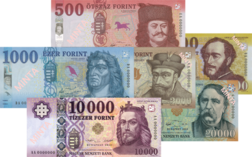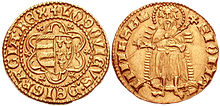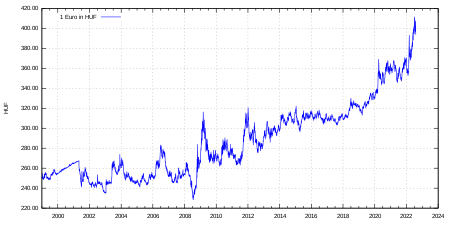| Magyar forint (Hungarian) | |
|---|---|
 Hungarian forint banknotes Hungarian forint banknotes | |
| ISO 4217 | |
| Code | HUF (numeric: 348) |
| Subunit | 0.01 |
| Unit | |
| Plural | forintok (nominative only) |
| Symbol | Ft |
| Denominations | |
| Subunit | |
| 1⁄100 | fillér (defunct) |
| Banknotes | 500 Ft, 1,000 Ft, 2,000 Ft, 5,000 Ft, 10,000 Ft, 20,000 Ft |
| Coins | |
| Freq. used | 5 Ft, 10 Ft, 20 Ft, 50 Ft, 100 Ft, 200 Ft |
| Demographics | |
| Date of introduction | 1 August 1946 |
| Replaced | Hungarian adópengő |
| User(s) | |
| Issuance | |
| Central bank | Hungarian National Bank |
| Website | mnb |
| Printer | Hungarian Banknote Printing Company |
| Website | penzjegynyomda |
| Mint | Hungarian Mint Ltd. |
| Website | penzvero |
| Valuation | |
| Inflation | 3.8% (January 2024) |
| Source | ksh |
| Method | CPI |
The forint (Hungarian pronunciation: [ˈforint] , sign Ft; code HUF) is the currency of Hungary. It was formerly divided into 100 fillér, but fillér coins are no longer in circulation. The introduction of the forint on 1 August 1946 was a crucial step in the post-World War II stabilisation of the Hungarian economy, and the currency remained relatively stable until the 1980s. Transition to a market economy in the early 1990s adversely affected the value of the forint; inflation peaked at 35% in 1991. Between 2001 and 2022, inflation was in single digits, and the forint has been declared fully convertible. In May 2022, inflation reached 10.7% amid the Russian invasion of Ukraine and economic uncertainty. As a member of the European Union, the long-term aim of the Hungarian government may be to replace the forint with the euro, although under the current government there is no target date for adopting the euro.
History
| This section needs additional citations for verification. Please help improve this article by adding citations to reliable sources in this section. Unsourced material may be challenged and removed. (February 2015) (Learn how and when to remove this message) |


The forint's name comes from the city of Florence, where gold coins called fiorino d'oro were minted from 1252. In Hungary, the florentinus (later forint), also a gold-based currency, was used from 1325 under Charles Robert, with several other countries following Hungary's example.
Between 1868 and 1892, the forint was the name used in Hungarian for the currency of the Austro-Hungarian Empire, known in German as the Gulden. It was subdivided into 100 krajczár (krajcár in modern Hungarian orthography; cf German Kreuzer).
The forint was reintroduced on 1 August 1946, after the pengő was rendered worthless by massive hyperinflation in 1945–46, the highest ever recorded. This was brought about by a mixture of the high demand for reparations from the USSR, Soviet plundering of Hungarian industries, and the holding of Hungary's gold reserves in the United States. The different parties in the government had different plans to solve this problem. To the Independent Smallholders' Party–which had won a large majority in the 1945 Hungarian parliamentary election–as well as the Social Democrats, outside support was essential. However, the Soviet Union and its local supporters in the Hungarian Communist Party were opposed to raising loans in the West, and thus the Communist Party masterminded the procedure using exclusively domestic resources. The Communist plan called for tight limits on personal spending, as well as the concentration of existing stocks in state hands.
When the forint was introduced, its value was defined on the basis of 1 kilogram of fine gold being 13,210 Ft (or 1 Ft = 75.7 mg fine gold). Therefore, given that gold was fixed at £8 8s (£8.40 in modern decimal notation) sterling per troy ounce, one pound sterling was at that time worth about 49 forint.
Coins
Main article: Coins of the Hungarian forintIn 1946, coins were introduced in denominations of 2, 10, 20 fillérs and 1, 2, 5 forints. The silver 5 forint coin was reissued only in the next year; later it was withdrawn from circulation. Five and 50 fillérs coins were issued in 1948. In 1967, a 5 forint coin was reintroduced, followed by a 10 forint in 1971 and 20 forint in 1982.
In 1992, a new series of coins was introduced in denominations of 1, 2, 5, 10, 20, 50, 100 and (a somewhat different, 500‰ silver) 200 forint. Production of the 2 and 5 fillér coins ceased in 1992, with all fillér coins withdrawn from circulation by 1999. From 1996, a bicolor 100 forint coin was minted to replace the 1992 version, since the latter was considered too big and ugly, and could easily be mistaken for the 20 forint coin.
Silver 200 forint coins were withdrawn in 1998 (as their nominal value was too low compared to their precious metal content); the 1 and 2 forint coins remained legal tender until 29 February 2008. For cash purchases, the total price is now rounded to the nearest multiple of 5 forint (to 0 or to 5). A new 200 forint coin made of base metal alloy was introduced in place of the 200 forint banknote on 15 June 2009.
Banknotes
Main article: Banknotes of the Hungarian forintIn 1946, 10 and 100 forint notes were introduced by the Hungarian National Bank. A new series of higher quality banknotes (in denominations of 10, 20 and 100 forints) were introduced in 1947 and 1948. 50 forint notes were added in 1953, 500 forint notes were introduced in 1970, followed by 1,000 forints in 1983, and 5,000 forints in 1991.
A completely redesigned new series of banknotes in denominations of 200, 500, 1,000, 2,000, 5,000, 10,000 and 20,000 forints was introduced gradually between 1997 and 2001. Each banknote depicts a famous Hungarian leader or politician on the obverse and a place or event related to him on the reverse. All of the banknotes are watermarked, contain an embedded vertical security strip, an invisible ink design and are suitable for visually impaired people. The 1,000 forints and higher denominations are protected by an interwoven holographic security strip. The notes share the common size of 154 mm × 70 mm (6.1 in × 2.8 in). The banknotes are printed by the Hungarian Banknote Printing Corp. in Budapest on paper manufactured by the Diósgyőr Papermill in Miskolc.
Commemorative banknotes have also been issued: 1,000 and 2,000 forint notes to commemorate the millennium (in 2000) and a 500-forint note to commemorate the 50th anniversary of the 1956 revolution (in 2006).
The 200-forint banknote was withdrawn from circulation in 2009, as its value inflated over time. Also due to the embarrassment caused by the fact that the model of the portrait on the banknote, purported to be of King Charles Robert (of whom no authentic contemporary depictions survived), turned out to be of an acquaintance of the designer, the managing director of the security company that supplied the banknote printing company. The banknote was replaced by a bimetallic 200-forint coin featuring the iconic Széchenyi Chain Bridge.
Forgery of forint banknotes is not significant. However, forged 20,000 forint notes printed on the paper of 2,000 forint notes after dissolving the original ink might come up and are not easy to recognize. Another denomination preferred by counterfeiters was the 1,000 forint note until improved security features were added in 2006.
Worn banknotes no longer fit for circulation are withdrawn, destroyed and turned into briquettes which are donated to public benefit (charitable) organizations to be used as heating fuel.
In 2014, a new revised version of the 1997 banknote series was gradually put into circulation beginning with the 10,000 Ft banknote in 2014 and completed with the 500 Ft banknote in 2019.
In 2022 after Russia's invasion of Ukraine, the EUR-HUF exchange rate breached the 400 forints per 1 euro line for the first time, but rates at that level or higher lasted until the end of 2022. Some time later, the forint also depreciated against the US dollar, breaching the same line. The forint is still more than 400 forints per 1 euro in November 2024. Against the US dollar the forint strengthened more markedly, returning to levels below 400 in November 2022 and below 350 in April 2023.
Current exchange rates
| Current HUF exchange rates | |
|---|---|
| From Google Finance: | AUD CAD CHF CNY EUR GBP HKD JPY USD TRY |
| From Yahoo! Finance: | AUD CAD CHF CNY EUR GBP HKD JPY USD TRY |
| From XE.com: | AUD CAD CHF CNY EUR GBP HKD JPY USD TRY |
| From OANDA: | AUD CAD CHF CNY EUR GBP HKD JPY USD TRY |
Historic rates
Forints per dollar, euro, etc.
|
Most traded currencies (from 31 December 1990):
Sources: arfolyam.iridium.hu |
Currencies of nearby countries (from 31 December 2010):
Sources: arfolyam.iridium.hu 
|
See also
References
- BBC News Hungary lifts last currency restrictions. 18 June 2001
- "1.1.1.2. Consumer price index by aggregate groups of consumption, and consumer price index for pensioners". www.ksh.hu. Retrieved 16 July 2022.
- Szakacs, Gergely (18 October 2021). "Hungary's new opposition PM candidate wants stronger ties with EU". Reuters. Retrieved 16 January 2022.
- Engel, Pál (2001). The realm of St. Stephen : a history of medieval Hungary, 895-1526. London: I.B. Tauris. ISBN 1-4175-4080-X. OCLC 56676014.
- "A stable currency in search of a stable Empire? The Austro-Hungarian experience of monetary union". History & Policy. 19 April 2017.
- "GLOSSARY". www.rev.hu. Retrieved 10 January 2021.
- "An Attempt at a New, Democratic Start: 1944–1946". The Institute for the History of the 1956 Revolution.
- Archived 21 February 2009 at the Wayback Machine 1 and 2 forint coins were withdrawn from use from 1 March 2008.
- Archived 21 February 2009 at the Wayback Machine The sum of total purchases is rounded
- Archived 4 March 2010 at the Wayback Machine The new 200 forint coin
- "Coins to replace 200 forint banknotes". www.mnb.hu. Retrieved 26 March 2022.
- "Coins". www.mnb.hu. Retrieved 26 March 2022.
- Calling for MNB-tender for public benefit organizations (MNB-pályázat közhasznú szervezetek számára)
- ^ "ECB euro reference exchange rate: Hungarian forint (HUF)". European Central Bank (in Hungarian). Retrieved 16 July 2022.
- "US Dollar (USD) to Hungarian Forint (HUF) exchange rate history". www.exchangerates.org.uk. Retrieved 16 July 2022.
- Krause, Chester L.; Clifford Mishler (1991). Standard Catalog of World Coins: 1801–1991 (18th ed.). Krause Publications. ISBN 0873411501.
- Pick, Albert (1994). Bruce, Colin R. II; Shafer, Neil (eds.). Standard Catalog of World Paper Money: General Issues (7th ed.). Krause Publications. ISBN 0-87341-207-9.
Further reading
- Gyula Rádóczy; Géza Tasnádi (1992). Magyar papírpénzek 1848–1992 (Hungarian paper money 1848–1992). Danubius Kódex Kiadói Kft. ISBN 963-7434-11-9.
- Károly Leányfalusi; Ádám Nagy (1998). Magyarország fém- és papírpénzei 1926–1998 (Coins and paper money of Hungary 1926–1998). Magyar Éremgyűjtők Egyesülete, Budapest. ISBN 963-03-6023-3.
- Károly Léányfalusi; Ádám Nagy (2006). Magyarország fém- és papírpénzei 1946–2006 (Coins and paper money of Hungary 1964–2006). Magyar Éremgyűjtők Egyesülete, Budapest. ISBN 978-963-7122-16-3.
- Mihály Kupa id. dr. (1993). Corpus notarum pecuniariarum Hungariae I–II. (Magyar Egyetemes Pénzjegytár) (General Hungarian Banknote Catalog). Informatika Történeti Múzeum Alapítvány, Budapest. ISBN 963-04-3658-2.
External links
- Official Daily Exchange Rates Archive, Hungarian National Bank
- (in Hungarian and English) bankjegy.szabadsagharcos.org (Hungarian banknote catalog)
- (in Hungarian and English) www.numismatics.hu (Roman and Hungarian related numismatic site)
- (in Hungarian) papirpenz.hu (pictures of Hungarian banknotes)
- (in Hungarian) Current HUF/EUR and other rates with charts
- (in Hungarian, English, German, and French) www.eremgyujtok.hu (homepage of the Hungarian Coin Collectors' Society)
- Hungarian banknotes (high resolution pictures, also including old forint banknotes)
- Comprehensive catalog of Hungarian coins
- Hungarian National Bank – "Information on forint banknotes and their security features, and forint coins"
| Preceded by: Hungarian pengő Reason: inflation Ratio: 1 forint = 4×10 pengő (theoretically) |
Currency of Hungary 1 August 1946 – Concurrent with: adópengő until 30 September 1946 |
Succeeded by: Current |
| Preceded by: Hungarian adópengő Reason: inflation Ratio: 1 forint = 200,000,000 adópengő |
| Historical currencies of Hungary | ||||||||||||||||||||||
|---|---|---|---|---|---|---|---|---|---|---|---|---|---|---|---|---|---|---|---|---|---|---|
| ||||||||||||||||||||||
| Currencies named florin or similar | |
|---|---|
| Circulating | |
| Defunct |
|
| As a denomination | |
| Future | |
| See also |
|
| Currency symbols | |
|---|---|
| Circulating | |
| Obsolete and historical | |
| Cryptocurrency | |
| Generic placeholder | |
| Currencies of Europe | |
|---|---|
| European Union |
|
| Eastern |
|
| Southern | |
| Western |
|
| Euro topics | |||||||||
|---|---|---|---|---|---|---|---|---|---|
| General | |||||||||
| Administration | |||||||||
| Fiscal provisions | |||||||||
| Economy | |||||||||
| International status | |||||||||
| Denominations |
| ||||||||
| Coins by country with minting rights |
| ||||||||
| Non-EU territories using euro per agreement without minting rights | |||||||||
| Potential adoption by other countries | |||||||||
| Countries and territories using euro unilaterally | |||||||||
| Other extant EU currencies |
| ||||||||
| History |
| ||||||||